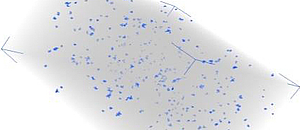
Project Call
Impact of Filler Dispersion on Mechanical Performance and Lifetime of Elastomers
Summary
The project aims are to develop and improve methods for the analysis of lifetime relevant particle size distributions in filler reinforced rubber compounds. This is promising to reduce the development costs for high-performance compounds, especially considering durability.
State of the Art
In compounding and further manufacturing of elastomer parts, the filler dispersion is well known as a crucial property for the final article performance. While the micro-dispersion - referring to particle sizes below e.g. 1 micrometer - affects the strength of the matrix due to the reinforcement effect, the macro-dispersion above e.g, 10 micrometers refers to typically more seldom particle sizes but reflects the amount of unwanted stress raisers which may initiate cracks. Especially considering lifetime under dynamic load, insufficient dispersion of filler or other additives has been found to shorten the lifetime endurance of dynamically tested specimens tremendously.
Hence, it is of high interest to define reliable and preferably quick methods for the dispersion evaluation on both scales. Whereas well-established methods like Dispergrader and DIAS have been proven useful for the evaluation of macro-dispersion in principle, they are of limited use for life-time relevant but seldom big particles due to their small effective test volume. Here, Computed tomography (CT) proves to be useful, a new method allowing for the investigation of volumes bigger by several decades in only one measurement, overcompensating for a longer evaluation time.
Since CT is not yet generally accepted for compound analysis, systematic tests with parameter verification are required to develop reproducible procedures for filler dispersion analysis. By comparison of the abovementioned dispersion analytical methods and evaluation of their result correlation with laboratory mechanical performance and lifetime tests, valuable information for compound development and processing can be generated, which is promising to shorten development time and increase efficiency.
Objectives
• Development of well-defined particle dispersion analytical methods especially with CT
• Evaluation of the correlation of compounding methodology with particle size distribution
• Modelling of the influence of distinct particle size classes on mechanical properties and application relevant lifetime performance
• Comparison of the optical methods with the aim to define of more reliable tolerance bounds for online-quality control.
Materials & Methods
Various compounds relevant to practice according to the project partners requirements, based on technical polymers, with carbon black or silica/silane.
• Compounding with variation of mixing procedures.
• Rheological measurement (Rubber Process Analyzer)
• Optical standard dispersion analytical method (DIAS, Dispergrader)
• Transmission Electron Microscopy (micro-dispersion)
• CT analysis with varying parameters, testing for reproducibility, sensitivity and to balance the available resolution with the choice of test volume
• Mechanical measurement of endurance in dynamic fatigue (Wöhler), fatigue crack growth (Paris-Erdogan), DMTA, physical properties
• Evaluation of the match of the dispersion analytical methods, together with the correlation with the mechanical test results; quantitative lifetime simulations
Time and project management
The project is designed for two years with optional third year. The project period covers the period from 1st April 2021 to 31st March 2023, optional to 2024.
Every three to four months, project meetings will take place between the DIK and the project partners with report on the project interim situation. DIK also undertakes to provide a conference call for these project meetings. The meetings are also intended to coordinate the progress of the project and, if necessary, to adapt the work plan on the basis of existing results.
Project deliverables
Within the scope of the project it is planned to deliver the following results to the partners:
• Data of the compounding, analytics and performance experiments carried out within this project
• Insights into the scope of application of methods to be used, in particular for the computed tomography in the determination of flaw size statistics.
• Documentation on the evaluation procedures developed for particle size distribution
• One intermediate and a final report
Costs
After material and labour costs, the following costs are incurred:
Total costs per year: 90,000 EUR excl.VAT
Total project costs over 2 years: 180,000 EUR plus the legal costs. VAT
Possible as bilateral or multi-client project, where the costs will be devided by the number of partners.
Use of personnel
The project will be carried out by one scientific co-worker (PhD-student) and will be supervised by Dr. Jens Meier and Dr. Harald Geisler. In addition, a student assistant is hired as required.
Contact information:
DIK Dr. Jens Meier Jens.Meier@DIKautschuk.de +49 511 84201-28
DIK Dr. Harald Geisler Harald.Geisler@DIKautschuk.de +49 511 84201-12

